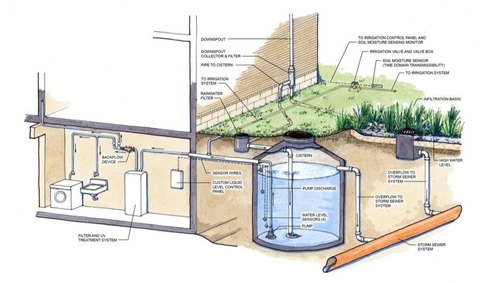Storage of Direct Use
- In this method, the rainwater collected from the roof of the building is discharged into the water storage tank. The design of the storage tank should take into account the water demand, rainfall and the availability of the catchment area.
- There should be a filter in the mouth of each drain, and there should be an initial drain, followed by a filtration system, and then connected to the collection container. Each water tank must have an overflow system to contain the excess water.
- Excess water could be diverted to the recharge system. Water from storage tanks can be used for secondary purposes such as washing and gardening etc. This is the most cost-effective way of rainwater harvesting
- The main benefit of collecting and using rainwater during the rainy season is not only to save water from traditional sources, but also to save energy when transporting and distributing water at the When it is used to meet demand when it rains, it can also save groundwater.
Recharge of Bore Wells
Rainwater collected from the rooftop of the building is diverted through drainpipes to settlement or filtration tank. After settlement, filtered water is diverted to bore wells to recharge deep aquifers. Abandoned bore wells can also be used for recharge.
Optimum capacity of the settlement tank/filtration tank can be designed based on the area of catchment, intensity of rainfall, and recharge rate. While recharging, entry of floating matter and silt should be restricted because it may clog the recharge structure.
The first one or two showers should be flushed out through rain separator to avoid contamination.
Recharge Pits
Recharge pits are small pits of any shape rectangular, square, or circular contracted with brick or stone masonry wall with weep hole at regular intervals. Top of the pit can be covered with perforated covers. The bottom of the pit should be filled with filter media.
The capacity of the pit can be designed based on the catchment area, rainfall intensity, and recharge rate of the soil. Usually, the dimensions of the pit may be of 1 to 2 m width and 2 to 3 m deep, depending on the depth of previous strata. These pits are suitable for recharging of shallow aquifers, and small houses.
Soakway or Recharge shafts:
Soak away, or recharge shafts are provided where the upper layer of soil is alluvial or less porous. These are the bored hole of 30 cm dia. up to 10 to 15 m deep, depending on the depth of the pervious layer. Bore should be lined with slotted/perforated PVC/MS pipe to prevent the collapse of the vertical sides.
At the top of the soakaway, the required size sump is constructed to retain runoff before the filters through the soakaway. Sump should be filled with filter media.
Recharge of Dug wells:
Dug wells can be used as a recharge structure. Rainwater from the rooftop is diverted to drilled wells after passing it through the filtration bed. Cleaning and desalting of dug well should be done regularly to enhance the recharge rate. The filtration method suggested for bore well recharging could be used.
Recharge Trenches:
The recharge trench is provided where upper impervious layer of soil is shallow. The recharge trench excavated on the ground and refilled with porous media like pebbles, boulders, or brickbats. It is usually made for harvesting the surface runoff.
Bore-wells can also be provided inside the trench as recharge shafts to enhance percolation. The length of the trench is decided as per the amount of runoff expected.
This method is suitable for small houses, playgrounds, parks, and roadside drains. The recharge trench can be of size 0.50 to 1.0 m wide and 1.0 to 1.5 m deep.
Percolation Tank:
Percolation tanks are artificially created surface water bodies, submerging a land area with adequate permeability to facilitate sufficient percolation to recharge the groundwater. These can be built on big campuses where land is available, and topography is suitable.
Surface runoff and roof topwater can be diverted to this tank. Water accumulating in the tank percolates in the solid to augment the groundwater.
The stored water can be used directly for gardening and raw use. Percolation tanks should be built in gardens, open spaces, and roadside greenbelts of urban areas.


